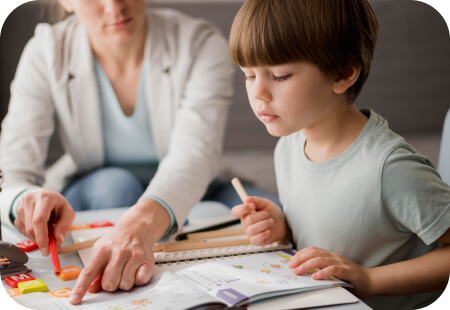It's clear that in many ways being a parent in our current time is easier than the same job in the eras of our parents or grandparents. Some of the difference comes down to advances in technology, notably the advent of the Internet. We have powerful tools like Google and YouTube that bring the answer to virtually any question to our fingertips in a few clicks. An endless stream of games and videos can keep our children entertained and occupied for hours, but this raises alarm bells with many parents who are concerned about the impact this could have on the new generation. It becomes all too tempting to give our children an iPad to soothe them if they're feeling bored, fussy, or angry.
In parallel with the many benefits of parenting in a digital-first era, there is a growing concern over two words: screen time. The fear is that excessive time spent in digital activities will cause short-term or long-term damage to our child’s mental health. The numbers sound staggering. According to a recent survey by Common Sense Media, those aged 8 to 12 spend around 4.75 hours of screen time per day, and teenagers average around 7.15 hours (not including time for school or homework).
Too much screen time can certainly be a negative for children, but there's a good case to be made that measuring all types of screen time the same way misses critical differences that can have deep impact on their development. We'll explore those differences below and try to draw lines in how to navigate this complex issue. Ultimately, there is a strong argument to be made that it's not the amount of screen time that matters but rather how that time is spent.
A Long-Lasting Fear
The negative connotation of screen time didn’t emerge with the rise of mobile phones and tablets. Fears about new visual technologies and excessive screen time can be traced back to 1951. There, Earnest A. Hooton, an anthropologist, said that this new invention called the television was “a visual education in how to do wrong.” Three years later, noted psychiatrist and author Fredric Wertham was concerned about how screen time from television was teaching kids that killing (especially shooting) was a way to cope with or solve a problem.
The same feelings of concern emerged with the rise of video games and the computer. In 2002, for instance, the American Academy of Pediatrics released guidance stating that there should be no media use for children under two, that two to five-year-olds should be extremely limited in their media consumption, and that kids over five shouldn’t consume more than two hours of media per day. While the AAP later revised this guidance, it goes to show that the dangers of excessive screen time have been feared for decades. These fears have reemerged with the rise of mobile devices and mobile devices.
Not All Screen Time is Equal
Recognize that the concern about screen time is real and founded, it's important to observe that not all types of screen time are alike. There are four broad categories of screen time:
- First, there is creative screen time, which is about making things like videos, music, and digital art.
- Communicative screen time includes things like FaceTime and Skype.
- Active screen time centers on gaming and searching.
- Finally, passive screen time is consuming mendia such as television withhout actively doing anything else.
As you can guess, passive screen time is the type that gets most of the attention becasue it invokes the stereotype of a “zombie” chid in front of a screen. It's also where the majority of screen time was spent until recently. Concerned parents and educators often equate that type of screen time as being essentially brainless. The fear is that this type of screen time can lead to physical and mental issues in a child’s development.
That being said, this doesn’t have to be the reality for every child or situation. To begin with, not all types of television are bad for children. It's possible without too much effort to carefully curate a watch list of shows that will open up a chid's eyes to a whole world of knowledge in fun ways. Series such as Sesame Street, The Magic School Bus, Daniel Tiger's Neighborhoos, and many more and are all good ways to learn that are fun and engaging. There is also nothing inherently wrong in letting a child watch a movie or television show—so long as it is done in moderation and the content is appropriate.
Parents also have the power to leverage their child’s screen time in ways that go well beyond what television and traditional media offer. For instance, instead of watching a movie or YouTube show, there are dozens of apps that can help your child build their creative confidence by making art or music. You could also use your child’s screen time to teach them the importance of family and community by staying connected with an out-of-state relative. Playing an educational game can teach a child a new skill or how to improve an existing one. A good educational app can become a regular supplement to their school curriculum, or even a powerful teaching tool when parents aren't experts or can't afford to hire an expensive tutor. When it comes to leisure, there are endless posibilties in the form of digital technologies many of which are unique interactive entertainment that allow children novel experiences. If you haven't experienced a game of Just Dance with a group of kids, it's a blast you'll never forget! In sum, paying close attention to the child's screen time can go a long way in getting the most out of it.
Focusing on the Bigger Picture
We now live in a digital-first world. There’s no going back to an era where we aren’t heavily reliant on our cell phones, tablets, and other devices. They bring huge benefits to our daily lives and can be used as powerful tools to enhance our children's lives. Like most technologies, they can be negative or positive depending on how they're used, and it's up to parents to help guide their children towards an intelligent use of their screen time.
Instead of focusing on completely eliminating digital technologies for our children, it is more productive to influence the use of screen time to become a positive factor in their lives. Don’t forget about the four different types of screen time and capitalize on creative, communicative and active screen times while minimizing passive ones. Making educated, well-founded decisions for your child’s screen consumption is a critical part of their success and will become increasingly so in the future as the many elements of our lives continue to go digital.








